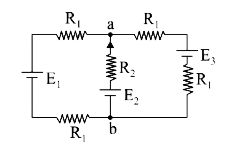Calculate the current through each resistance in the given circuit. Also calculate the potential difference between the points a and b.
E1=6V,E2=8V,E3=10V,
R1=5Ω,R2=10Ω,R3=4Ω
Assume that all the cless have no internal resistance.

The process of solving a circuit involves three steps:
i. Assume unkonwns (x, y, ….) for currents in different
branches of the circuit. Use Kirchhoff's Current law at
the junctins so that the number of unknowns introduced
is minimum. Let x be the current through R1 and y be the
current through R3 as shown in Fig. 5.74. Kirchhoff's
current law at the junction a gives a current (x-y)
through R2

ii. Selectas many loops as the number of unknows introduced
for currents. Apply Kirchhoff's voltage law throgh every
loop. Going anticlockwise through the loop containing
R1andR3(starting from junction a), we get
+xR1−E1+yR3+E3=0
or 5x +4y = -4 ....(i)

Going clockwise through the loop containing R2andR3 (starting from juction a), we get
−R2(x−y)−E2+yR3+E3=0
or 5x - 7y =1 (ii)
Some currents may come out to be negative. This simply
means that their directions were incorrectly assumed. so the signs of the currents will given us the correct direction
of each current. Solving Eqs. (i) and (ii) we get
x=−2455andy=−511A
∴x−y=155A
This signs indicate that the direction of x and y were
assumed incorrectly, while the direction of (x-y) was
correct. So
current i1(through R1)=2455A toward left
current i2(through R2)=155 A toward right
current i3(through R3)=511 A upward
The current directions are shown in the circuit diagram

iii. Potential difference between a and b
The potentia difference between any two points in a
circuit is calculated by adding the changes in potential
while going through any path form one point to the other
point. Hence, let us go from b to a through R3.
Va−Vb=+yR3+E3=(−511)×4+10=9011v
Topper's Solved these Questions
- ELECTRIC CURRENT AND CIRCUITBOOK - CENGAGE PHYSICSCHAPTER - ELECTRIC CURRENT AND CIRCUITEXERCISE - Solved Examples
12 Videos
- ELECTRIC CURRENT AND CIRCUITBOOK - CENGAGE PHYSICSCHAPTER - ELECTRIC CURRENT AND CIRCUITEXERCISE - Exercise 5.1
28 Videos
- ELECTRIC CURRENT & CIRCUITSBOOK - CENGAGE PHYSICSCHAPTER - ELECTRIC CURRENT & CIRCUITSEXERCISE - Kirchhoff s law and simple circuits
15 Videos
- ELECTRIC FLUX AND GAUSS LAWBOOK - CENGAGE PHYSICSCHAPTER - ELECTRIC FLUX AND GAUSS LAWEXERCISE - MCQ s
38 Videos
Similar Questions
In Fig. 27-9, what is the potential difference V.d−Vc between points d and c if ε1=4.0V.ε2−1.0V,R1=R2=10Ω,andR3=8.0Ω, and the battery is ideal?
View SolutionFind the magnitude and direction of the current flowing through the resistance R in the circuit shown in Fig. if the emf's of the sources are equal to E1=1.5V and E2=3.7V and the resistances are equal to R1=10Ω,R2=20Ω,R=5.0Ω. The internal resistances of the sources are neglible.

View Solution
Knowledge Check
In the network shown the potential difference between A and B is (R=r1=r2=r3=1Ω,E1=3V,E2=2V,E3=1V)
 A1VB2VC3VD4V
A1VB2VC3VD4VIn the network shown the potential difference between A and B is (R=r1=r2=r3=1Ω,E1=3V,E2=2V,E3=1V)
 A1 VB2 VC3 VD4 V
A1 VB2 VC3 VD4 VIn the circuit shown, E1=7V,E2=7V,R1=R2=1Ω and R3=3Ω respectively. The current through the resistance R3
 A0.083333333333333B3.5 AC1.75 ADnone of these
A0.083333333333333B3.5 AC1.75 ADnone of these
In the network shown the potential difference between A and B is R(=r1=r2=r3=1Ω,E1=3V,E2=2V,E3=1V)

View SolutionIn the following circuit ,E1=4V,R1=2Ω,
E2=6V,R2=2Oemga,andR3=4Ω. Find the currents i1andi2

View SolutionFor the circuit shown, with R1=1.0Ω,R2=2.0Ω,E1=2VandE2=E3=4V the potential difference between the points ‘a’ and ‘b’ is __________(in V)

View SolutionDetermine the voltage drop across the resistor R1 in the circuit given below with E = 65V, R_1 = 50 OmegaR_2 = 100 Omega, R_3 = 100 Omega, and R_4 300 Omega.

View SolutionThe emf of a cell is ε and its internal resistance is r. its termnals are cannected to a resistance R. The potential difference between the terminals is 1.6V for R = 4 Omega, and 1.8 V for R = 9 Omega. Then,
View Solution
